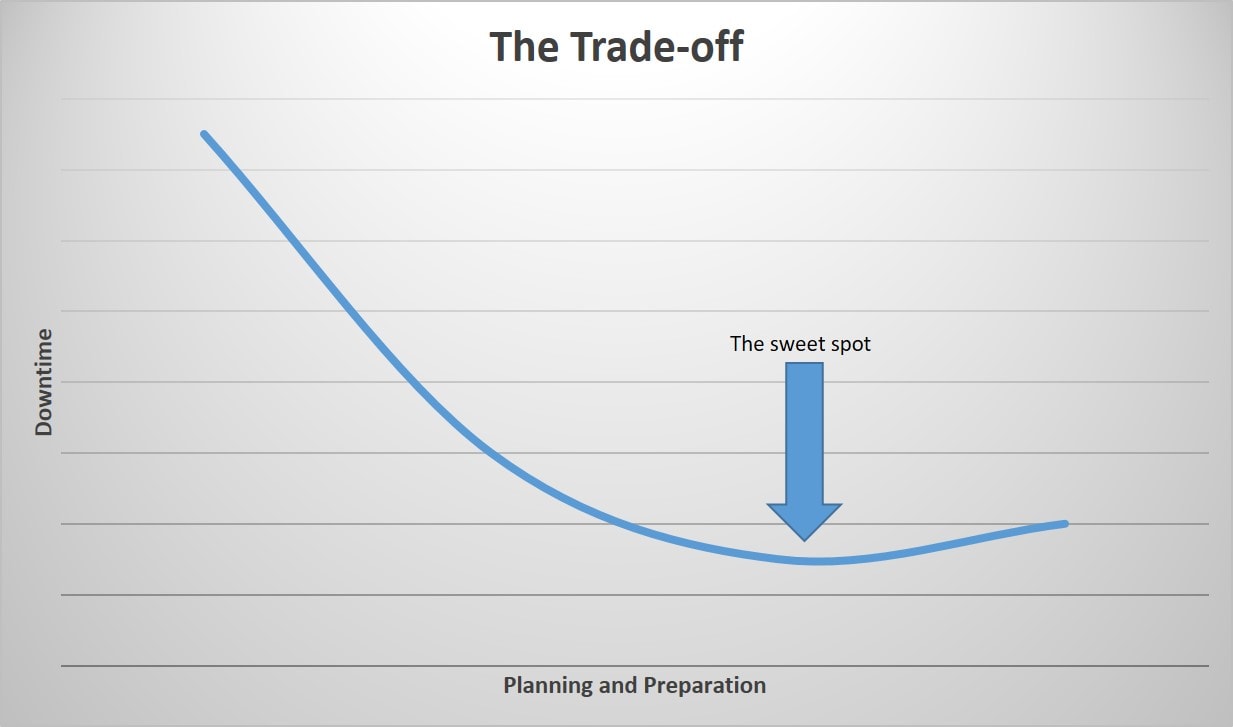Preparation is the key to maximizing uptime
How to maximize uptime while minimizing the cost of doing so
At KlareTech we deal daily with a broad customer base as our core business is providing support for automated machinery.
An ongoing theme in my daily discussions with customers over the phone and in meetings with them is "maximizing uptime" of their machinery. Of course keeping a machine in production is a key focus area for a company that relies on machines to generate their income. A standing machine is a liability while a running one is a very real asset.
So how then does almost every customer enquiry we receive at KlareTech involve the need for an urgent component because "the machine is standing and I'm losing thousands of Rands every hour!"?
The premise is that maximizing uptime and reducing the cost of so doing are always at odds with each other and finding the correct balance between the two can be tricky. It is human nature to focus on this issue less when the machine is up and running, which is the very time that one has the opportunity to make a real impact on the severity, cost and timeline of the next breakdown.
1. Getting a budget together

It is obvious that too little planning and preparation will lead to more downtime, yet this is exactly the spot most customers find themself in during a breakdown, realizing too late, for example, that the required parts have a long lead time with expensive penalties for rushing them in from overseas, or are no longer available at all.
Less obvious is the fact that too much planned maintenance can increase downtime as well due to more-than-required time spent in planned shutdowns and the issues often related to restarting machinery afterwards.
Finding the "sweet spot" is the key, getting the balance right can firmly divide success and failure in a manufacturing plant. I think that perhaps most of our customers see the illusive "sweet spot" much further to the left of the graph than it actually is in reality. This leads to much higer production losses than necessary with breakdowns that could last minutes often lasting days while parts and or technicians are air-freighted in at high costs in order to try to resolve the issue.
I would advise anybody who has a production machine to run a simple monthly metric based on a 12 month history of the machine before deciding how much money, time and other resources they should dedicate to preparing for and preventing breakdowns.
1. Calculate how much unplanned downtime has cost you in the last 12 months: machine production value per hour x total unplanned downtime For example: If a machine earns you R10,000 / hour and it has stood for 48 hours in the last 12 months then it has cost you:
R10,000 x 48 hours = R480,000 in unplanned downtime production losses.
2. Add up the total spend on aquiring parts during the unplanned downtime in the last 12 months and do the same for the cost of shipping and additional technical support. If, for example, the parts total was R10,000 and the shipping was R15,000 then there is an obvious disparity in your spend that signals some planning issues may be present.
3. Add the totals from point 1 and 2 above together and you have a pretty good idea of what your costs have been in the last 12 months. Now halve that total cost and you have a budget for planning and prepairing that if executed correctly will increase the production value from the machine in question by up to 50% of the total you just calculated.
This is a very simple metric but it is very effective at highlighting how unprepaired you may actually be. In addition you will note that if you apply this planning successfuly to reduce your downtime costs that the cost of the planning will reduce evey month as the effect on downtime filters through to the 12 month rolling metric. Essentially, you will eventually reach some base rate which cannot be reduced and at that stage you will have minimized your downtime to some absolute lowest possible value while reducing the cost of so doing step by step along the way. The highest costs are incurred at the start of the process but the greatest gains in uptime are achieved at the same time.
When one looks at the problem this way it turns out that the opening premise of this article is not exactly correct and that in fact one can minimize both the downtime and the cost of so doing at the same time using a step by step refinement to carry out proper planning.
2. Spending the new planning and preparation budget effectively
So you've established a budget to spend using the method above, how should you maximize the gains of spending this budget in order to get the highest impact from it on your production?
2.1. Carry spares, carry spares, carry spares!
One of the simplest and most effective things you can do is carry your own spare parts. Do a plant-wide audit and create a list of common spares, place an order for one or two of each item and ship it in using the (normally free) long lead-time cosolidated shipping option from your supplier. Make sure your spares are well organized in your engineering department and do monthly or quarterly audits of your spares to ensure that ones which have been used have been replaced.
It sounds so simple yet the impact is high, if a machine goes down due to a faulty module and you have it in your spares store it can be replaced in under an hour, not to mention that having spares available is extremely useful for troubleshooting a faulty machine. If you don't carry a spare, then not only does the fault finding take longer but, even in the best case where a spare is locally available, you will have to wait for it to get to you which may take 3-6 hours and 24-48 hours if it is from an overseas supplier. In the case where the part comes from overseas you would incur additional express shipping charges and you have to wait for it to arrive before you can be sure that it solves the problem at all.
2.2. Spend time learning your machines
Effective fault-finding requires an indepth understanding of your machine and all of its components. This is the one place where an inhouse technician should always outshine an outsourced one. Knowing the particular nuances of your particular installation make all the difference. When the machine is running take the time to find all available documentation on the components used in the machine including sensors, control electronics, motors etc. Also spend time closely observing the process of the machine trying to understand which inputs trigger which responses. Draw up an overall system architecture as you understand it and query grey areas with the machine supplier. Having all of this under your belt the next time the machine has a problem can change the game completely.
2.3. Attend training courses and practice what you learn
Attend relevant training courses but spend some of your planning budget on equipment which allows you to set up a practice rig in order to practice what the course teaches you. This rig can usually be set up using the spares you have bought as per point 2.1. above which means you don't need to spend as much as you might think. Practice is the key to implementing your new skills correctly during a high-pressure breakdown situation and having spent time connecting diagnostic tools to your training rig and simulating errors you'll be well prepared for the real thing.
2.4. Reduce planned maintenance to a minimum
Yes, you read that right. Planned maintenance can cause more problems than it solves. It is important to do enough planned maintenance and to listen to your technicians advice when they say they don't have enough time to do it properly even in the face of production pressures from clients or internal forces.
But, make sure you aren't doing more harm than good, planned maintenance after all is downtime from a production point of view. In my experience being prepared for the next breakdown can be a lot more effective than preventing it all together in terms of balancing your costs and hitting the maximum production numbers by keeping your machine running when it is ready to run.
2.5. Group your orders efficiently
While modern production requires constant flexability from your machines, this comes at a high price in terms of the impact of downtime for tool and product changes on your overall efficiency. Strive to produce in bigger batches and watch you production flourish. All too often the blame for bad production numbers is placed on the shoulders of the technical team when actually they are under completely unrealistic expectations in terms of retooling for small production batches.
Implementing the above basic principles could see your profits sore. Feel free to contact us for assistance and give us feedback on your success!
-by Mike van Tonder, Sales and Software director at KlareTech.


